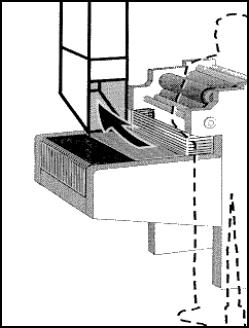
HC24
![]()
Press operators and other workers in printing establishments are exposed to airborne solvent vapors generated when the press is cleaned. Press-cleaning solutions are generally a mixture of chemicals that include various solvents, some of which are carcinogens. Adverse health effects from inhalation or skin contact include dermatitis, headaches, nausea, vomiting, dizziness, respiratory failure, central nervous system depression, coughing, difficult breathing, chest pains, unconsciousness, and death. Chronic effects may include kidney and liver damage. Many press operators in small print shops have excessive exposures because these shops frequently have inadequate ventilation or other controls for the vapors.
![]()
NIOSH researchers have demonstrated a control that reduces exposures to cleaning-solvent vapors to acceptable concentrations. This approach includes substitution, ventilation, work practices, and personal protective equipment.
Wipers used for cleaning become saturated with cleaning solvents and should be stored in a closed container until they are removed from the shop to prevent inhalation of vapors.
Squeeze bottles used to apply the cleaning solvents are filled from larger containers. These containers should be located in a separate, well-ventilated room or at least close to an exhaust inlet to avoid over-exposures from the filling operation.
Many liquid cleaning solvents are absorbed through the skin. Therefore, chemical protective gloves should be worn whenever skin contact is possible. These solvents often penetrate or permeate generic materials such as natural rubber latex gloves (i.e., surgical gloves). The manufacturer of the cleaning solution and the gloves can provide recommendations for the appropriate chemical protective gloves. But first, the Personal Protective Equipment Section on the Material Safety Data Sheet should be consulted for recommendations

To obtain more free information about controlling this hazard or about other occupational safety and health issues:
| — call NIOSH* at 1-800-35-NIOSH (1-800-356-4674), or — visit the NIOSH Homepage on the World Wide Web at |
For general approaches to the design of ventilation systems and examples of a large number of local exhaust applications, refer to the following publication: American Conference of Governmental Industrial Hygienists. A manual of recommended practice, 22nd ed. Cincinnati, OH [1995].
The principal contributors to this publication are Keith G. Crouch, Rosmarie T. Hagedorn, Richard Carlson, and Jerome P. Flesch.
| This document is in the public domain and may be freely copied or reprinted. NIOSH encourages all readers of this HAZARD CONTROLS to make it available to all interested employers and workers. |